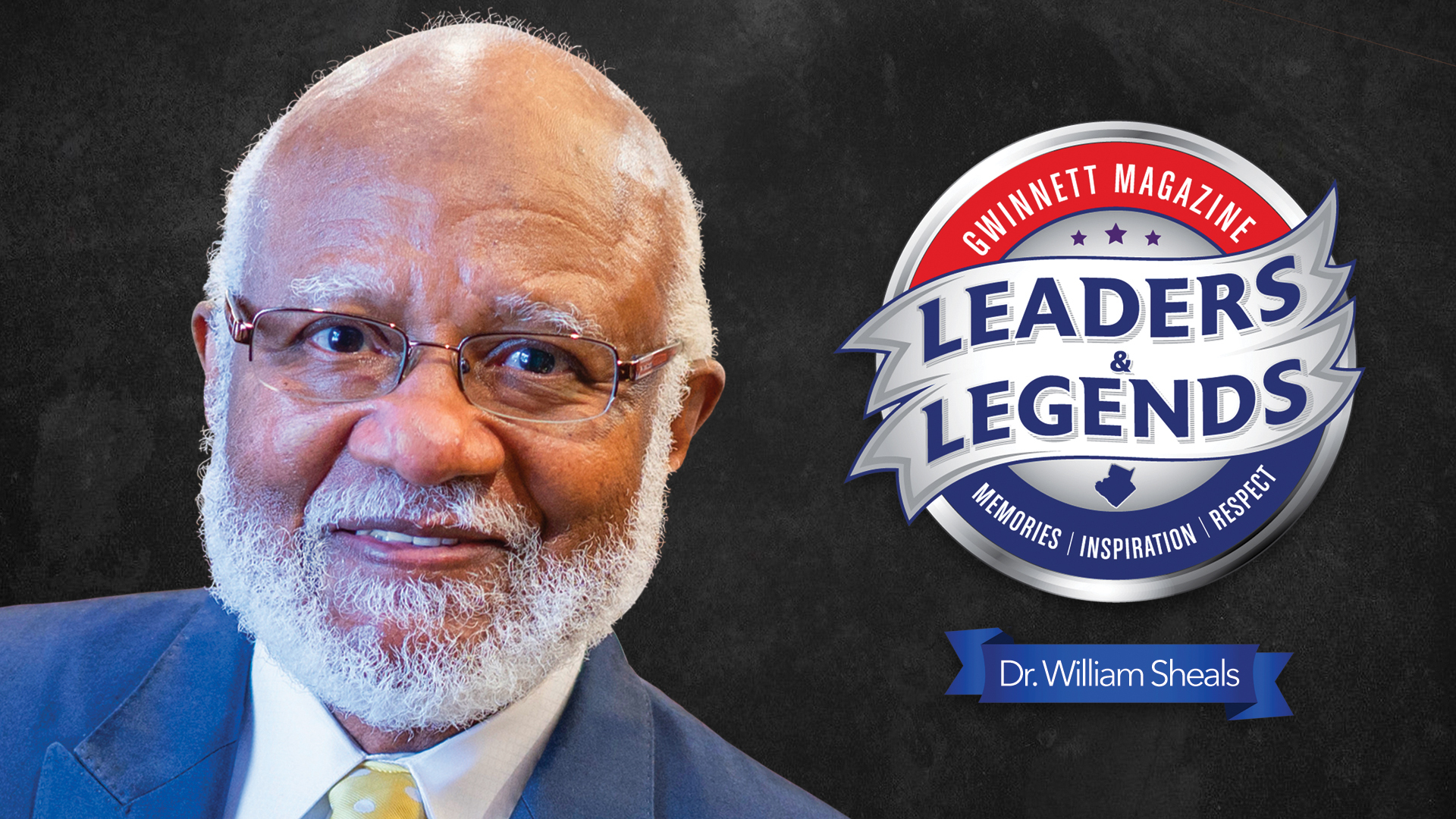
Leaders & Legends: Dr. William L. Sheals
There’s a framed illustration on the wall outside the office of Dr. William L. Sheals. It’s a rough pencil sketch of a church building and adjoining architecture on the back cover of a legal pad. Across the roof of one building are the words “ED. BLDG,” and on the other, “ADM. BLDG.”
Across the roof of the building drawn in the center, beneath a steeple rising to the top of the legal pad’s margin, are the words “CITY OF HOPE.”
If you stood right this moment in the parking lot of the historic Hopewell Missionary Baptist Church in Norcross you’d plainly see the seeds – sketched in pencil on the back of that framed legal pad – of what would one day come to be.
“That’s the original vision, the original drawing on the back of a legal pad,” Sheals says, leading a tour through the administration building. “At the time, I didn’t have but one piece of paper left on the pad, and it had already been written or drawn on … and then, the pen wouldn’t work.”
Sheals laughs, recalling this vision he had – back when the only thing near what was then a very small Hopewell Baptist Church was a junkyard and cemetery.
“We were apparently operating very lean … so I got a pencil, sketched it out as I’d seen the vision. I showed it to the deacons of the church at the time, and they said, ‘we can’t do that.’ And I said, ‘Oh yes, we can because God gave me this vision.”
Hopewell Missionary Baptist Church would grow in the early 1980s from a two-acre, one-building facility with 200 members to what now sits on 30 acres and boasts a membership of nearly 17,000 members and 60 ministries and auxiliaries. The City of Hope today includes a senior citizens facility, 500-member youth church, child development center, a Christian academy and more.
If not for that vision decades earlier, the City of Hope would have been little more than a junkyard near an old church building. The answer to why Sheals had the faith to, first, sketch his drawing and then see it through to fruition lies in a bible verse, which is written beneath the drawing:
Habakkuk 2:2 and an inscription:
Write the Vision and Make It Plain.
Sheals Theater
Several years before the monumental vision that would lead to the building of the City of Hope, Sheals had a series of visions that would shake up his life.
At the time a radio DJ and concert promoter living in Florida, Sheals woke up one Sunday morning after a concert he’d been promoting the night before.
“The Lord came into my bedroom … I saw an image of the Christ figure sitting on a pillow with four men on each end,” Sheals says. “The image was engulfed in smoke. I was frightened. I sat up in my bed.”
Several weeks later, it happened again. This time a voice told him, “Preach my word. Preach the Gospel.” Sheals says God immediately took away his desire to continue his path of radio and concert promotion.
This was unusual and must have struck him as odd at the time; the desire to entertain people and cheering crowds was an inclination present in Sheals even as a young man.
For instance, at the age of 12, Sheals recalls setting up his own movie theater in his childhood home of Lakeland, Florida.
Using the tube from a paper towel roll, a cardboard box, a magnifying glass and one of the lamps in his parents’ bedroom, he built a makeshift projector.
“I’d cut the wording off the comic strips and stack them up,” Sheals recalls, laughing. “And it would project onto the wall in color.”
For 25 cents each, kids around the neighborhood would line up to see these shows at “Sheals Theater.” He says sometimes 50 or 60 kids would stand in a winding queue that led to his home.
“And my sister and I would make refreshments – ice cups with grape or cherry Kool Aid in the little dixie cups. The kids would come into the bedroom and watch the comic strip. ‘The adventures of Superman!’ I’d shout. ‘Faster than a speeding bullet!’ I did the soundtrack, the voices, everything. I’d make stories out of the comic strips that projected on the wall, and the stories were never the same twice.”
At the same time, he worked at a Publix in Lakeland, Florida, bagging and delivering groceries. Sheals’ grocery delivery work – he and other local kids on bikes with baskets carting goods to nearby houses – flourished.
With his grocery delivery and movie theater work combined, he’d have enough money every Christmas to buy presents for everybody in his family from the age of 12 to 17.
“That was the beginning of my entrepreneurship,” Sheals says.
Triple S Productions
That entrepreneurial spirit in the boy foretold a career for the young man in the 1970s that would encompass record store ownership, employment as a disc jockey, work in the banking industry as well as acting in several off-Broadway plays and big production, big budget films.
Living in New York at the time, he played small roles in both “The French Connection,” (1971) and “Come Back Charleston Blue” (1972). “My part got left on the cutting room floor (in ‘The French Connection’) but I’ve still got a copy of my check,” he says.
When Sheals’ father died, he returned to Florida to mourn with family. He ended up staying in Florida, where he would soon thereafter open a record store and clothing store as well as working as a disc jockey for a Top 40 station in Lakeland, Florida and later working for an R&B station in Tampa.
His work in the music industry led to a career as a concert promoter. He promoted shows for groups like Earth, Wind and Fire; the O’Jays; the Doobie Brothers; and Gladys Knight and the Pips.
“Any major artist coming through Florida during that era, they came through Triple S Productions (Sheals, Sights and Sounds),” Sheals says. “I was in my 20s and making a lot of money … but it wasn’t about the money. It was all about taking nothing and making something out of it and employing my nephews and brothers in the family.”
Adds Sheals: “They’ve all got homes in Florida now because of the business. No concert came into the state of Florida unless it came through my company.”
While being surrounded by others who smoked marijuana, drank alcohol or did other kinds of recreational drugs, Sheals says he maintained a strictly sober stance.
“I was ministering then, and I didn’t even know it,” he says. “I was demonstrating that you could have fun and enjoy life on a natural high – entertaining people and employing people too.”
One morning after helping promote an Earth, Wind, and Fire show, Sheals had the vision of Christ at his bedside. Thus began the road to Gwinnett County.
Hopewell and its history
He preached his first sermon at the church he attended in Florida. It was a success, he says.
“Fifteen people accepted Christ and joined the church that day,” Sheals says.
He would shortly thereafter hear about a job in Atlanta as assistant director of the city’s housing authority. Yet another post he’d held while in Lakeland, Florida prior to his departure for Georgia was assistant director of the Lakeland Housing Authority, so the move to Atlanta would be a natural fit.
He took the job in Atlanta in 1979 and, while working for the housing authority, continued to feel the call to the ministry. Sheals soon learned that the congregation of Hopewell Baptist was looking for a new pastor. It was a historic church, founded by former slaves after the Civil War.
Sheals got an official offer on April 2, 1980 and preached his first sermon on the following Easter Sunday. He would continue working for the Atlanta Housing Authority and preaching at Hopewell for the next 10 years, when he decided to devote his time entirely to the rapidly growing church.
Sheals says being part of the history of Hopewell Missionary Baptist Church is “a blessing. It is amazing and inspiring.”
He’s heard tales from members of the congregation of the early days of Hopewell, when a 5-day revival would be hosted in one of the original church buildings.
“The young ladies who attended church would spend time that year sewing five new outfits for those five nights because that was the highlight of the year,” he says. “This was when there were maybe 30 or 40 people in attendance.”
There were times then during some Sunday sermons when the roof would begin to leak. Members of the church kept umbrellas close by – popping them open mid-sermon so they could hear the full message. Sheals says, present day, there are members of Hopewell whose ancestors attended during early days like those described above.
Times have changed. While the church held services merely two Sundays a month back in those days, today, Hopewell not only holds service every Sunday but 3 to 4 services every Sunday.
“It’s amazing what God has done,” Sheals says. “There was a time in the not so distant past when a majority of the Black kids who attended Gwinnett County Public Schools were members of Hopewell…and to think a lot of this property was just a junkyard. Now … this!”
Atlanta native, comedian and actor George Wallace remembers when the property near Hopewell was little more than a junkyard as well. As a child growing up in Atlanta, his family would sometimes visit Hopewell – what was then a very small church.
“We would come up there sometimes, and all you saw (near the church) was just a cemetery and junkyard,” says Wallace who has attended the church off and on for some 20 years now. “What Dr. Sheals has done with that place now, it’s just amazing. Bishop Sheals has been an amazing pastor and leader for that community.”
‘Write the vision’
The framed legal pad outside Sheals office that bears the original conception for the new church campus and the City of Hope is a physical testament to just how far they’ve come.
There are other memories and mementos around Sheals office and the administration building as well that attest to its growth as well as its ever-expanding outreach – which brings in members from a 50-mile radius.
A photo album of a trip Sheals took to South Korea last year for instance shows the bishop in the foreign country preaching to tens of thousands of congregants as part of a 5-day revival.
Following the trip to Korea, he preached in Los Angeles before coming home. Sheals would shortly thereafter in May 2020 undergo successful heart surgery. And he’s still going strong today on his home turf in Norcross.
The church stresses the community aspect – holding vaccination clinics; monthly grocery pickups for families in need; Christmas drives for those in need; as well as a secret santa-style effort called “Papa Claus.”
It all goes back to Sheals’ beliefs as well as the beliefs he says go back to the rich history of Hopewell Baptist Church – that the church should be “the community backbone.”
“I believe that every church must follow the patterns and teachings of Jesus Christ,” Sheals says, recounting specific scripture from the gospels. “He taught them, but he also fed them. Physical food and spiritual food. At the Sermon on the Mount, he preached to 5,000 … and after he had given the sermon … he fed them.”
Another scripture, Habakkuk 2:2 remains of the utmost importance. Its words are imprinted beneath the framed legal pad outside Sheals office, which bear early renderings of what would become the future for Hopewell Missionary Baptist Church.
“Write the Vision and Make It Plain.”



